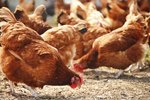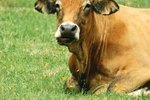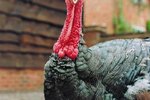
Oxen are renowned for their strength and working ability, hence the old saw "strong as an ox." An ox is simply a castrated bull that's over the age of 4. If you're looking for oxen for plowing, pulling or other farm work, you have many breeds and sizes to choose from.
Oxen
Also known as bullocks, oxen are trained castrated male bovines. An ox weighs roughly the same amount as an intact male, or bull, of his particular breed. The ox grows taller than the bull and has less muscling in the neck and chest. Typically, bulls don't serve as working animals because of their strong sex drive and aggressive behavior. Steers are castrated males either less than 4 years old or not trained. Most steers end up as meat.
Dairy vs. Beef Breeds
Overall, dairy breeds make better oxen than beef breeds, based on their level of physical activity. Dairy breeds tend to move more in pasture settings than their beef counterparts. According to the Prairie Ox Drovers website, a cross between a beef breed and a dairy breed makes a good choice for an ox, as this animal has the energy of the dairy breed with the larger size of the beef breed.
Three-Purpose Breeds
Some cattle were bred to serve three purposes within a lifetime: milk, draft work and meat. Among these "all-purpose" breeds still in existence are the milking Devon, a red animal topping out at 1,600 pounds; the 2,000-pound milking shorthorn, available in red, white and roan; the Randall Lineback, a 1,200-pound black ox with a white line down the back; and the Ayrshire, a rarer breed weighing in at 1,600 pounds. The Ayrshire is quite colorful, white with red or reddish spots and brown legs.
Smaller Breeds
If you're looking for a smaller pair, consider the Dexter. Mature Dexter oxen will weigh 900 pounds or less. The breed is known for its docile disposition and its ability to subsist on less-than-ideal pastures. Dexters are generally black, although red ones exist.
Oxen for Cold Climates
If your farm in a particularly harsh climate, consider the Highland ox, a breed that weighs up to 2,000 pounds and has huge horns. Available in many shades, Highland cattle boast long, thick coats. The belted or solid-color Galloway is another breed known for its ability to thrive in harsh climates. These shaggy oxen also top out at 2,000 pounds.
Choosing Oxen
Since most oxen work in pairs, you'll want two animals of relatively the same size and strength. They should travel at the same speed -- don't pair a fast-walking ox with a slow one. A working pair must carry their heads at the same height, and their horns must be similar in length and shape. If appearances matter to you, find a pair of the same color and similar markings. The most important thing is that the two work well together and are willing to work.
References
Photo Credits
-
Thinkstock/Comstock/Getty Images
Writer Bio
Jane Meggitt has been a writer for more than 20 years. In addition to reporting for a major newspaper chain, she has been published in "Horse News," "Suburban Classic," "Hoof Beats," "Equine Journal" and other publications. She has a Bachelor of Arts in English from New York University and an Associate of Arts from the American Academy of Dramatics Arts, New York City.



